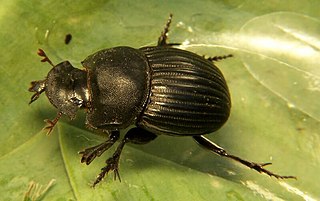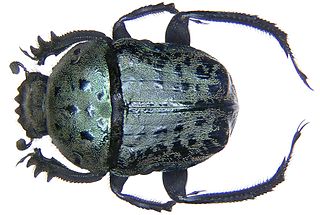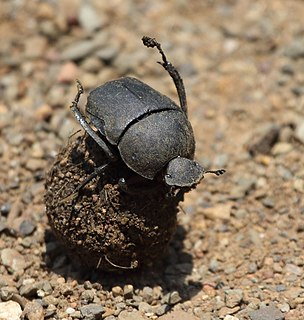
Kheper is a subgenus of Scarabaeus: the typical genus of scarab beetles in the tribe Scarabaeini. The genus name honors the god Khepri in the ancient Egyptian religion, who is depicted as having a scarab for a head. Kheper can be found on the border between Botswana, Namibia, and South Africa in the arid sand dunes. This genus of scarab beetles share a family with the oldest and most revered scarab beetles, the Scarabaeus sacer.

Dung beetles are beetles that feed on feces. Some species of dung beetles can bury dung 250 times their own mass in one night.

The scarab beetle subfamily Scarabaeinae consists of species collectively called true dung beetles. Most of the beetles of this subfamily feed exclusively on dung. However, some may feed on decomposing matter including carrion, decaying fruits and fungi. Dung beetles can be placed into three structural guilds based on their method of dung processing namely rollers, dwellers and tunnelers Dung removal and burial by dung beetles result in ecological benefits such as soil aeration and fertilization; improved nutrient cycling and uptake by plants, increase in Pasture quality, biological control of pest flies and intestinal parasites and secondary seed dispersal. Well-known members include the genera Scarabaeus and Sisyphus, and Phanaeus vindex.

Copris is a genus of dung beetles in the tribe Coprini of the scarab family. It comprises more than 250 tunnelling species and has an almost worldwide distribution.

Sisyphus is a genus of dung beetles comprising more than 90 species. Adults are characterised by their long hind legs.

Allogymnopleurus is a genus of scarab beetles in the tribe Gymnopleurini. It includes 20 species; 17 are restricted to the Afrotropics, one is Afrotropical/Palearctic, and two Oriental.

Catharsius is a genus of dung beetles in the tribe Coprini in the scarab family.

Epirinus is a genus of dung beetles in the tribe Deltochilini of the scarab family. It comprises 29 species from southern Africa; a few species are widespread in the region, but most have limited ranges. Length ranges from 3.0 mm to 13.5 mm.

Euoniticellus is a genus of dung beetles in the subfamily Scarabaeinae of the scarab beetle family.

Garreta is a genus of dung beetles in the scarab beetle family (Scarabaeidae). There are more than 20 described species; most are African and some are from Asia. They are generally found in fairly moist habitats.

Oniticellus is a genus of dung beetles in the subfamily Scarabaeinae of the scarab beetle family.
Versicorpus is a genus of Scarabaeidae or scarab beetles in the superfamily Scarabaeoidea. Versicorpus is endemic to Namibia and is only found at the Mount Erongo. This is a monotypic genus with only one species, Versicorpus erongoensis.

Sceliages, Westwood,, is a sub-genus of the Scarabaeus dung beetles, and are obligate predators of spirostreptid, spirobolid and julid millipedes, having renounced the coprophagy for which they were named. The genus is near-endemic to Southern Africa, Sceliages augias exceptionally ranging as far north as the Democratic Republic of Congo.

Gymnopleurini is a tribe of scarab beetles, in the dung beetle subfamily (Scarabaeinae), but it may now be combined with the Scarabaeini. The side edge of each elytron has a characteristic shape that exposed the underlying pleural sclerites. Relative to other dung beetles they are of moderate size.

Coprini is a tribe of scarab beetles, in the dung beetle subfamily (Scarabaeinae). Scholtz et al. describe them as tunnellers that are shiny black, of moderate to large size and with a strongly convex shape. They also, however state that the grouping based on these characteristics has little phylogenetic validity, and the placement of several genera in this and related tribes is likely to change.

Metacatharsius is a genus of dung beetles in the tribe Coprini of the scarab family. It comprises more than 60 species from Africa; one is also found in Arabia, and Pakistan.

Deltochilini is a tribe of scarab beetles, in the dung beetle subfamily (Scarabaeinae). Members of this group vary widely in size and shape, but were thought to be derived from an ancient ball-rolling lineage. The outer edges of the front tibiae have less than four teeth. The grouping based on these characteristics has, however, been found to have little phylogenetic validity, and the placement of several genera in the tribe is likely to change.

Sarophorus is a genus of dung beetles in the tribe Ateuchini of the family Scarabaeidae. It comprises about ten species from Africa.

Saphobius is a genus of dung beetles in the tribe Deltochilini of the subfamily Scarabaeinae. They are endemic to New Zealand, with Saphobius edwardsi being most widespread. They are small in size, flightless, forest dwelling and nocturnal, which is unusual for dung beetles.
Sisyphus crispatus, is a species of dung beetle found in India, Sri Lanka and Pakistan.


















